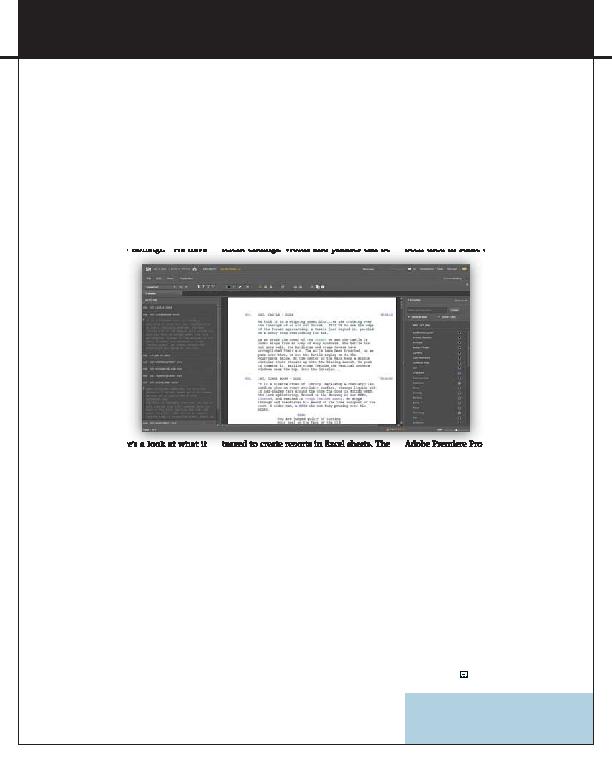
news, observations and points of view
to buzz@creativescreenwriting.com.
development tool Adobe Systems will be re-
leasing in the near future. Perhaps it should
not come as a surprise that Adobe has cre-
ated software for Hollywood, considering
that its products such as Photoshop,
Dreamweaver and others are already widely
used in the industry. "Adobe has always
been in the business of building great tools
for creative people," says Adobe Story prod-
uct manager Anubhav Rohatgi. "We have
leading video postpro-
duction applications
in Adobe Creative
Suite 5 Production Pre-
mium and entering in
the preproduction
space is a logical ex-
tension of our product
line." The current ver-
sion of Story is still in
beta form, meaning it
is currently available
for free, but will even-
tually be bundled with
CS5 Production Pre-
mium once it's ready
to hit the market. Here's a look at what it
has to offer screenwriters.
and Importing/Exporting
downloading the Story AIR application to
their desktops. The online setting allows
users to share scripts in a variety of ways.
The sender can email a URL and the re-
ceiver can simply click and open the docu-
ment. The receiver can be assigned one of
three roles: co-writer (access to write and
change the script), reviewer (access to read
and make notes on the script) and reader
(access to only read the script).
downloaded to a computer. Any changes
made to a script in the offline setting are
automatically synced once the user is back
online. Scripts can be exported in a vari-
ety of formats: PDF, XML, Text, Word and
Movie Magic Scheduling. Users can im-
and Movie Magic.
Other Innovative Tools
acter bios. Additionally, each project can
have several scripts within itself. This is a
good idea in case a writer has a different ver-
sion of a script -- say, one with several dif-
ferent endings. Words and phrases can be
SmartType feature helps speed up typing.
Story builds an Outline as a script is created
and allows users to see scene headings that
can be selected to instantly "jump" to the
place in the script. The Outline also shows
which characters are present in the scene by
displaying a unique color square that repre-
sents each character. Another great feature is
the shot duration capability, which assigns
each scene with an approximate estimate on
how long it would take to play out.
production and postproduction," Rohatgi
explains. "Utilizing script metadata increases
efficiency in the workflow." Adobe Story is
envisioned as being an all-in-one package op-
tion for production companies, studios and
independent writer-producers. Essentially,
Story uniquely connects a script-writing soft-
ware with other production functions such
as filming, editing and after effects. To this
end, Adobe Story is intertwined with OnLo-
cation CS5, Premiere Pro CS5, Encore CS5
to serve as a collaborative tool for different
people in a production process. "It is really
the next generation in scriptwriting tools. It
combines previously separate processes into
one, providing a backend database, film
script format, A/V format, Multicolumn for-
mat, shoot script and tagging," Rohatgi says.
Monsters and The Social
Network. According to
Adobe's website, Adobe
Systems worked closely
with James Cameron's
production crew to cre-
ate the characters and
the virtual world of
Pandora. This process
of creating characters
began in Photoshop.
The initial footage for
The Social Network was
edited in Final Cut Pro
and imported into
was then entirely conformed in After Effects
CS5.
likely to ultimately be integrated into the
production process. Adobe Story is not com-
pletely ready, but interested consumers are
encouraged to sign up for a free account to
try it out. Readers are encouraged to wait
until the polished version is available for pur-
chase. Rohatgi expects Adobe Systems to
"continue to innovate Story's film and shoot-
ing script formats as well as its breakdown re-
ports. We anticipate filmmakers will see Story
as an essential tool to the video production
workflow as well." With this in mind, it
would behoove screenwriters to give Adobe
Story a look.